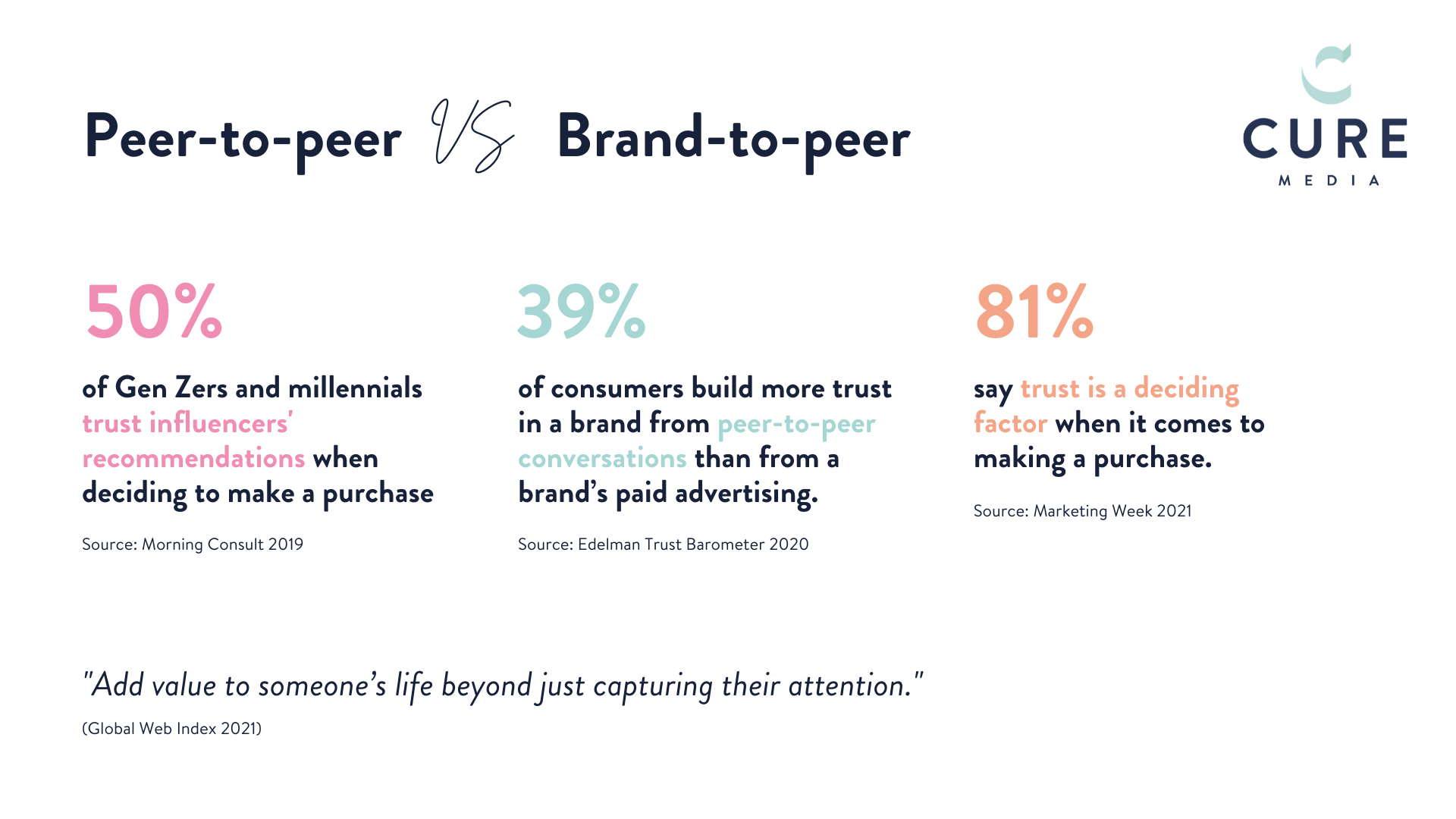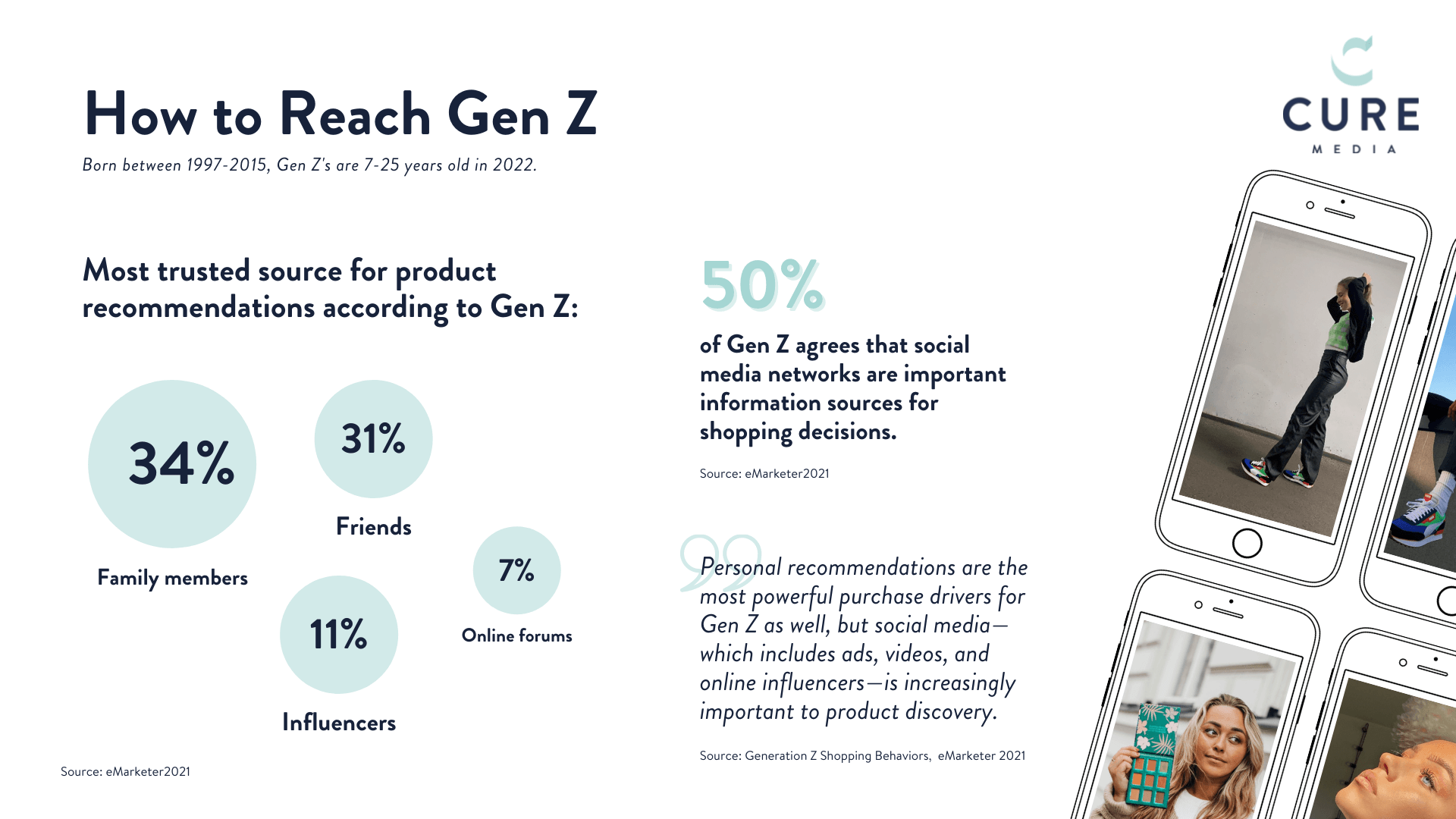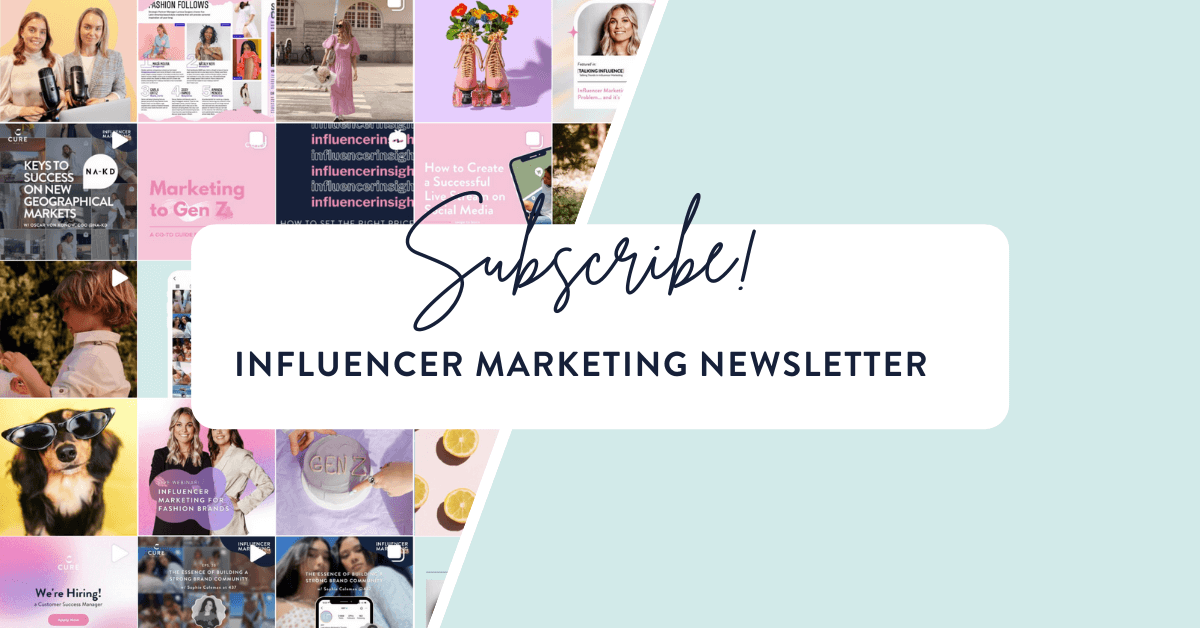One of the top influencer marketing trends for 2022 is that Gen Z and Millennials expect brands to be authentic and transparent. However, unlike the TikTok feta pasta trend that left as quickly as it came, consumers’ demand for authenticity is here to stay. To meet this need, it’s important that brands adopt the right approach and style when trying to connect with their target audience. In this article, we’ll discuss the benefits of using peer-to-peer (P2P) marketing tactics compared to brand-to-peer (B2P) tactics. More specifically, we’ll take you through why Gen Z and Millennials favour P2P, the benefits of this marketing tactic, and how brands can make the most of P2P via influencer marketing.
What is the difference between brand-to-peer and peer-to-peer marketing?
B2P is effectively another way of saying business-to-consumer (B2C). These marketing activities are constructed in-house, or by an agency on behalf of a brand, to communicate a service or product’s benefits to its target audience. Brand-generated content is usually found on traditional platforms like TV and outdoor advertising, or digitally on a brand’s social channels.
P2P marketing, by contrast, takes place when a consumer advocates for a product or service to their peers. This method goes hand-in-hand with word-of-mouth marketing, the age-old tradition of recommending products to friends and family.
Despite P2P’s timeworn origins, marketers tend to think of B2P as the more traditional form of marketing. In reality, peer-to-peer marketing is the true original. After all, we’ve been turning to friends and family for advice long before modern marketing began.
How do today’s consumers feel about P2P marketing?
B2P and P2P marketing styles have a marked difference in their reception by consumers. Today’s consumers are a cynical bunch and are very hesitant to engage with commercial messages. This is especially the case for younger generations, who would rather receive product recommendations from a trusted friend or family member than the brand itself.
Consumers’ trust in P2P communication is supported by the numbers. Whereas only 15% of consumers trust content created by companies, 55% trust user-generated content (UGC). Further strengthening the case for P2P is the fact that almost 80% of all the purchases we make are influenced by friends, family members and other peers. You can see even more figures in support of P2P in the above graphic. It all comes down to trust!
Despite consumers’ strong preference for P2P communications, brands continue to prioritise B2P activities in their budgets. This traditional approach may feel like a safe choice, when in reality, failing to account for changes in consumer behaviour puts the entire brand at risk. As we touched upon in the opening of this blog, young shoppers demand transparency and authenticity. This can be delivered much more efficiently if communicated by somebody that genuinely loves your products instead of the brand itself.
How can brands maximise the benefits of P2P?
P2P works so well because people trust people more than they trust companies. When considering how your brand can best utilise peer-to-peer marketing, it’s important to begin by defining your goals. Are you interested in increasing brand awareness, or perhaps your engagement on social channels? Maybe your team is looking for a way to increase conversions?
If conversions are your top focus, a worthwhile P2P strategy could be a referral program. This strategy leverages the power of P2P by offering existing customers an account credit, a discount, or free products in exchange for a referral to their friends and family. The strength of this tactic is its authenticity and the likelihood of quick conversions, as referral programs rely on people recommending your product to those that trust them.
While P2P strategies like referral programs are great for quick conversions, they often lack the reach that brands need to connect with a wider audience. This is where influencer marketing comes into play. Influencer marketing is a great way to scale customer trust because, in most cases, we trust influencers as much as we trust our friends!
Visa detta inlägg på Instagram
Unlike commercial messages from brands, influencers communicate on platforms where consumers have chosen to spend their time; people follow influencers because they want to hear what they have to say. So, when an influencer makes a recommendation, their followers are more inclined to trust and act on this recommendation.
The benefits of doing influencer marketing at scale go beyond building customer trust
The content produced by influencers is unrivalled. They are true professionals when it comes to content creation and your brand can save time and money by repurposing this content on other channels. For example, you can use the influencer content you’ve already invested in to create paid social or banner ads. Not only that, but you can use this content in channels that usually lack P2P possibilities, such as TV commercials.
Employing influencer marketing as a trusted P2P method is especially useful when targeting the digital natives of Millennials and Gen Z. These generations expect brands to be transparent and to provide a sense of community–both of which can be delivered by partnerships with the right influencers.

To resonate even further with Millennials and Gen Z, you may want to consider incorporating smaller accounts, i.e. micro-influencers, into your P2P-focused marketing mix. These influencers are more likely to reflect the lifestyles of your target audience compared to celebrity names and mega-influencers.
In addition to better connecting with younger generations, constructing your strategy around micro-influencers is also an effective way to scale your P2P communications. While working with a high volume of micro-influencers may require the help of a micro-influencer agency, tapping into this large network of influencers will make it much easier to scale your influencer content. Having only 3 brand ambassadors won’t be enough to achieve the brand awareness you need in this competitive marketplace – even if it’s a step in the right direction. Your target audience needs to see much more of you if you want to stay top of mind!
To wrap-up…
P2P marketing tactics are an effective way to connect with your target audience on a deeper, more genuine level than brand-generated content allows for. Prioritising P2P methods is especially important for reaching Gen Z and Millennials.
If it’s younger shoppers you’re targeting (and remember, all shoppers will age into your consumer bracket eventually!) then P2P could well be a non-negotiable for your brand. Not only do P2P tactics build trust, but they are also a cost and time effective way of marketing. The long days of creating content from scratch and risking whether it will resonate with your audience are gone! In their place is content created by influencers with trusting communities of followers ready to receive recommendations for your brand. And finally, reaching these audiences is possible via the channel we scream and shout about the most – so you know which influencer marketing agency to reach out to!



